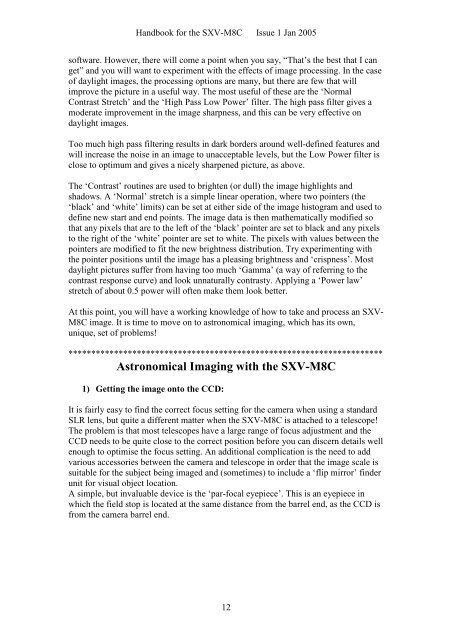SXV-M8C handbook.pdf - Starlight Xpress
SXV-M8C handbook.pdf - Starlight Xpress
SXV-M8C handbook.pdf - Starlight Xpress
- No tags were found...
You also want an ePaper? Increase the reach of your titles
YUMPU automatically turns print PDFs into web optimized ePapers that Google loves.
Handbook for the <strong>SXV</strong>-<strong>M8C</strong> Issue 1 Jan 2005software. However, there will come a point when you say, “That’s the best that I canget” and you will want to experiment with the effects of image processing. In the caseof daylight images, the processing options are many, but there are few that willimprove the picture in a useful way. The most useful of these are the ‘NormalContrast Stretch’ and the ‘High Pass Low Power’ filter. The high pass filter gives amoderate improvement in the image sharpness, and this can be very effective ondaylight images.Too much high pass filtering results in dark borders around well-defined features andwill increase the noise in an image to unacceptable levels, but the Low Power filter isclose to optimum and gives a nicely sharpened picture, as above.The ‘Contrast’ routines are used to brighten (or dull) the image highlights andshadows. A ‘Normal’ stretch is a simple linear operation, where two pointers (the‘black’ and ‘white’ limits) can be set at either side of the image histogram and used todefine new start and end points. The image data is then mathematically modified sothat any pixels that are to the left of the ‘black’ pointer are set to black and any pixelsto the right of the ‘white’ pointer are set to white. The pixels with values between thepointers are modified to fit the new brightness distribution. Try experimenting withthe pointer positions until the image has a pleasing brightness and ‘crispness’. Mostdaylight pictures suffer from having too much ‘Gamma’ (a way of referring to thecontrast response curve) and look unnaturally contrasty. Applying a ‘Power law’stretch of about 0.5 power will often make them look better.At this point, you will have a working knowledge of how to take and process an <strong>SXV</strong>-<strong>M8C</strong> image. It is time to move on to astronomical imaging, which has its own,unique, set of problems!*********************************************************************Astronomical Imaging with the <strong>SXV</strong>-<strong>M8C</strong>1) Getting the image onto the CCD:It is fairly easy to find the correct focus setting for the camera when using a standardSLR lens, but quite a different matter when the <strong>SXV</strong>-<strong>M8C</strong> is attached to a telescope!The problem is that most telescopes have a large range of focus adjustment and theCCD needs to be quite close to the correct position before you can discern details wellenough to optimise the focus setting. An additional complication is the need to addvarious accessories between the camera and telescope in order that the image scale issuitable for the subject being imaged and (sometimes) to include a ‘flip mirror’ finderunit for visual object location.A simple, but invaluable device is the ‘par-focal eyepiece’. This is an eyepiece inwhich the field stop is located at the same distance from the barrel end, as the CCD isfrom the camera barrel end.12
















